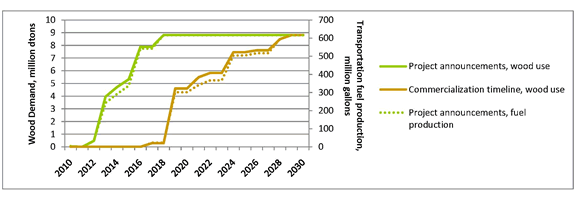Questions and comments regarding a study we published with the Schiamberg Group have focused on (1) why a given wood-using transportation fuel project is different or “special” and (2) potential impacts to timberland investors and managers. The study – Transportation Fuels from Wood: Investment and Market Implications of Current Projects and Technologies – includes the status of 36 cellulosic biofuel projects, estimated commercialization timelines for 12 technology approaches, and implications for bioenergy and timberland investors in the US. These projects seek to convert wood to fuels including ethanol, butanol, diesel, gasoline, and jet fuel.
With respect to the exact and extraordinary circumstances associated with each wood biofuels project, we defer to the late Senator Daniel Patrick Moynihan, who said “Everyone is entitled to his own opinion, but not his own facts.” Our research focused on verifiable, third-party sources to confirm the current status and commercial viability of known projects. While our team, as forestry “enthusiasts”, would love to see growing demand for wood and the associated incentives to increase investments in forestry and forest health, a project cannot be considered viable until the relevant technology has been proven at commercial scale. We encourage dialogue and will update our analysis as new facts present themselves.
For timberland investors, the overall, potential impacts from this sector appear modest, though specific local markets could benefit within the next ten years. On a national scale, demonstration and commercial projects could use up to 8.8 million dry tons of wood per year by 2030. According to project announcements, this total wood demand would occur by 2018. A commercialization scenario projects 8.8 million dry tons of wood per year 11 years later in 2029. In other words, we estimate an 11 year lag between when the projects expect to operate and when our technology analysis indicates the technology could overcome hurdles and be viable at commercial scale. This figure from the study illustrates the story:

The study models and graphs data for all US regions: the US South dominates the potential incremental wood use from the transportation fuel projects evaluated. At the most basic unit of analysis, the local wood basket circling each liquid fuel project, the population of timberland owners and investors with significant exposure to potential increases in raw material demand from announced projects would include those with timberland investments in markets that include lower risk, higher potential projects. These markets include Alabama; California; Michigan; Mississippi; and Tennessee.
While some projects show particular promise and advantages, our general results indicate that major technical hurdles will likely disrupt commercialization for most technologies under development.
This content may not be used or reproduced in any manner whatsoever, in part or in whole, without written permission of LANDTHINK. Use of this content without permission is a violation of federal copyright law. The articles, posts, comments, opinions and information provided by LANDTHINK are for informational and research purposes only and DOES NOT substitute or coincide with the advice of an attorney, accountant, real estate broker or any other licensed real estate professional. LANDTHINK strongly advises visitors and readers to seek their own professional guidance and advice related to buying, investing in or selling real estate.










It would seem with all the fanfare related to foreign oil and the large transfer of wealth out of our country that there would be great emphasis on this wonderful resource. I am a southern timberland owner and with the downward spiral in stumpage prices (lack of demand) this would seem a great alternative. This would help our foreign dependency, create a real wood demand and perhaps create a few jobs!
with trees talking so long to regrow (many years) I think it is retarded to create something we rapidly overconsume from something we already over consume. What about timber companies lobbying the government to pass The American Hemp Farming Act. The plant grows from seed to harvest in 100 days (not years and years and years) and over 25,000 planet friendly products can be made from it